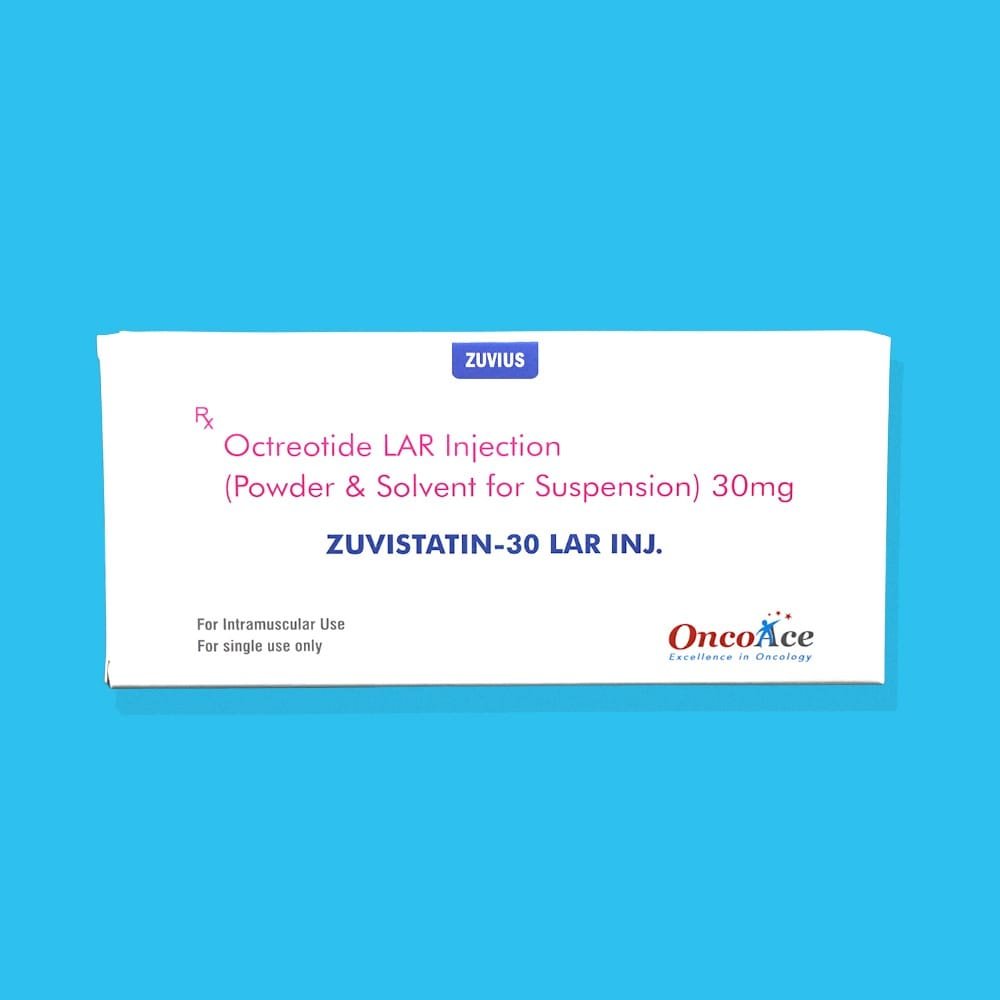Zuvistatin-30 LAR
Octrotide Acetate LAR
Strength: 30mg
Pack Size: 1 vial
Drug Class: Antidiarrheals; Somatostatin Analogs
Dosage and Administration:
- Zuvistatin should be administered by a trained healthcare provider. It is important to closely follow the mixing instructions included in the packaging. Zuvistatin must be administered immediately after mixing.
- Do not directly inject diluent without preparing suspension.
- The recommended needle size for administration of Zuvistatin is the 1½” 19 gauge safety injection needle (supplied in the drug product kit). For patients with a greater skin to muscle depth, a size 2” 19 gauge needle (not supplied) may be used.
- Zuvistatin should be administered intramuscularly (IM) in the gluteal region at 4-week intervals. Administration of Zuvistatin at intervals greater than 4 weeks is not recommended.
- Injection sites should be rotated in a systematic manner to avoid irritation. Deltoid injections should be avoided due to significant discomfort at the injection site when given in that area.
- Zuvistatin should never be administered intravenously or subcutaneously.
Cold Storage: yes
Octreotide is the acetate salt of a cyclic octapeptide. It is a long-acting octapeptide with pharmacologic properties mimicking those of the natural hormone somatostatin. Octreotide is known chemically as L-Cysteinamide, D-phenylalanyl-L-cysteinyl-L-phenylalanyl-D-tryptophyl-L-lysyl-L-threonyl-N-[2-hydroxy-1(hydroxy-methyl) propyl]-, cyclic (2→7)-disulfide; [R-(R*,R*)].
The molecular weight of octreotide is 1019.3 (free peptide, C49H66N10O10S2) and its amino acid sequence is:
 |
Zuvistatin LAR is indicated in patients in whom initial treatment with Sandostatin Injection has been shown to be effective and tolerated.
Acromegaly
Long-term maintenance therapy in acromegalic patients who have had an inadequate response to surgery and/or radiotherapy, or for whom surgery and/or radiotherapy, is not an option. The goal of treatment in acromegaly is to reduce GH and IGF-1 levels to normal.
Carcinoid Tumors
Long-term treatment of the severe diarrhea and flushing episodes associated with metastatic carcinoid tumors.
Vasoactive Intestinal Peptide Tumors (VIPomas)
Long-term treatment of the profuse watery diarrhea associated with VIP-secreting tumors.
Zuvistatin is a long-acting dosage form consisting of microspheres of the biodegradable glucose star polymer, D,L-lactic and glycolic acids copolymer, containing octreotide. It maintains all of the clinical and pharmacological characteristics of the immediate-release dosage form Sandostatin Injection with the added feature of slow release of octreotide from the site of injection, reducing the need for frequent administration. This slow release occurs as the polymer biodegrades, primarily through hydrolysis. Zuvistatin is designed to be injected intramuscularly (intragluteally) once every 4 weeks.
- Keep out of reach of children.
- Take as directed by physician.
Pregnancy
The limited data with Zuvistatin LAR in pregnant women are insufficient to inform a drug-associated risk for major birth defects and miscarriage. In animal reproduction studies, no-adversedevelopmental-effects were observed with intravenous administration of octeotride to pregnant rats and rabbits during organogenesis at doses 7-and 13-times, respectively the maximum recommended human dose (MRHD) of 1.5 mg/day based on body surface area (BSA).
Lactation
There is no information available on the presence of Zuvistatin LAR in human milk, the effects of the drug on the breastfed infant, or the effects of the drug on milk production. Studies show that octreotide administered subcutaneously passes into the milk of lactating rats; however, due to species-specific differences in lactation physiology, animal data may not reliably predict drug levels in human milk.
Pediatric Use
Safety and efficacy of Zuvistatin LAR in the pediatric population have not been demonstrated.






